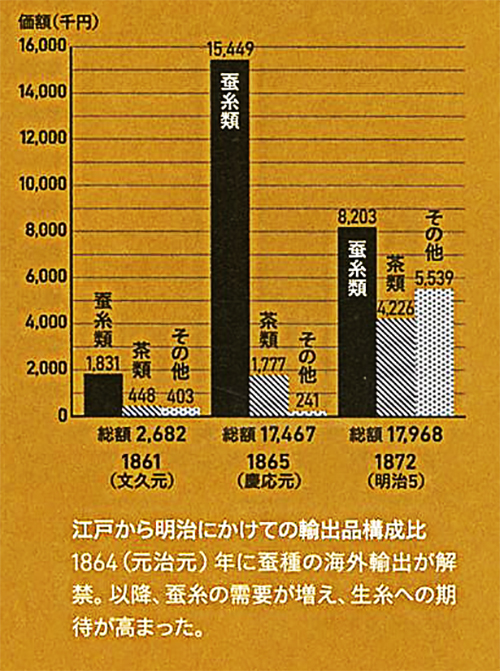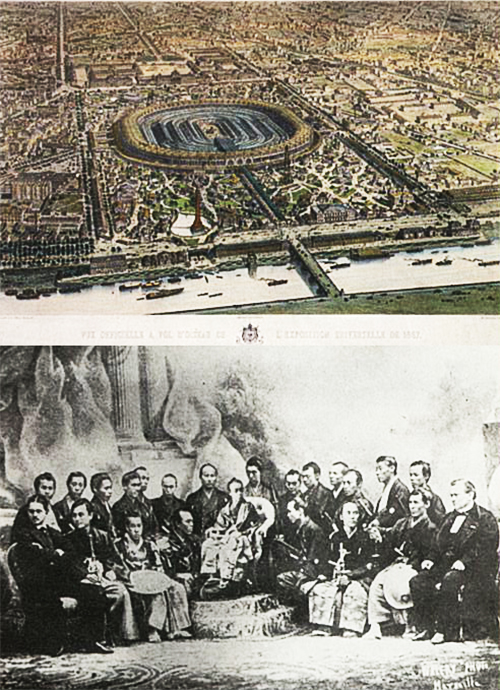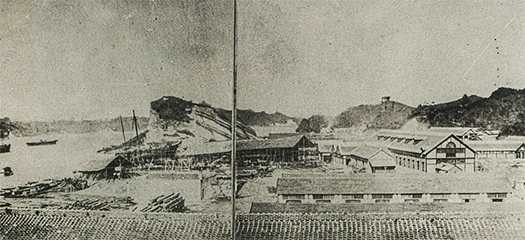

日本史の激動期、幕末明治初期の「経済構造」というのはあんまり歴史教育で触れられていないように思う。歴史としては政治・軍事的な側面に集中していて、その下部構造、どうしてそのような「革命」が起こるのかについての経済的側面を探究することが少ない。わたしは歴史が好きだったのだけれど、今回の富岡製糸場探訪ではじめてそういうことに興味を抱いた次第。
上のグラフは昨日も引用した「継承される革新の歴史」からのもの。もっと掘り下げていけばたくさんの詳細なデータがあるのかも知れないが、おおまかな把握としては十分に伝わってきた。日本からの「輸出産品」のグラフ図なのだけれど、蚕糸類の割合が非常に大きいことが知れる。ペリー来航が1853年7月のことで、欧米の「市場経済」が日本に対して「開国」を迫ってきた。
下の写真2点は1867年のパリ万博の全景写真と、そこに初出展したときの日本側代表団の記念写真。真ん中には将軍・慶喜の弟が団長として写っている。またその後富岡製糸場の計画を立案した渋沢栄一も写っている。この体験によって海外の「市場経済」のなかで日本が期待できる産業について、大きな実体感を得ることができたのだろうか。開国後、たくさんの貿易事業者たちが日本に対して蚕種事業への期待感を示し続けてきたことに、具体的な体感として共有できたのだろう。
グラフに戻ると以降、1861年、1865年、1872年の輸出品統計数字。1864年に「蚕種」〜蚕の卵のこと。蚕蛾に産卵させた紙を蚕紙(蚕種紙)といい蚕種製造業者によって製造された。〜の輸出解禁があって一躍、日本の経済を支える巨大産業としての期待が高まった。ところが、出荷と品質管理において解離が生じて、欧州市場で日本産の蚕糸類にクレームが寄せられることになった。それまでは養蚕農家からの直接出荷品がメインで、輸出時に品質チェックがどのように行われたのか、不明だった。海外での需要急増に生産体制が追いつかなかったということなのだろう。

こうした状況の中で、幕府の小栗上野介などの専決でフランスの技術導入によって、横須賀に製鉄所や造船所などが建設されていった。倒幕側にはイギリスが支援したけれど、幕府側にはフランスが技術支援していた。この富岡製糸場の構想から建設に至るまで、フランスの協力が大きかったことには、そういった伏線があったのだろうし、また最大の蚕種産業国家としてフランスは市場をリードする存在でもあったのだ。当時、フランスでは蚕種の疫病が蔓延していて、ほぼ原材料の枯渇が見られていた。その窮乏を救う最大供給国であった清国が内戦でその供給もほぼ途絶えていたという底流の国際情勢事実もあった。
明治初期の革命政権にとって「富国強兵」のための貿易強化、富の獲得にはいわば国家的な命運が掛かっていたとも言える。こうした状況の中で、最新のフランスの技術によって近代的製品管理された工場出荷の蚕種製品は、貿易立国日本を世界に広くメッセージする最初の産品となっていった。
日本の歴史の授業は最後、幕末〜明治以降については、学年末で「試験にもあまり出ない」という不文律からか深く教えないと思う。う〜む、この辺、歴史教育で深掘りして欲しかったなぁ・・・。
English version⬇
Trade Products at the End of the Edo Period and the Beginning of the Meiji Era: The Tomioka Silk Mill-5
During this turbulent period in Japanese history, opening the country to the world was synonymous with participation in the global market economy. We will explore the demand and supply trends in the world market. The following is a brief history of the Tomioka Silk Mill.
During the turbulent period of Japanese history, the “economic structure” at the end of the Edo period and the beginning of the Meiji period seems to have not been mentioned much in history education. History concentrates on the political and military aspects, and there is little exploration of the economic aspects of the substructure and why such a “revolution” took place. I have always loved history, but this visit to the Tomioka Silk Mill has made me interested in such things for the first time.
The above graph is from the “History of Inherited Innovations,” which I also quoted yesterday. There may be a lot of detailed data if we dig deeper, but it is enough to give us a rough idea of what is going on. The graph of “exported products” from Japan shows that the percentage of sericultural products is very large. The arrival of Perry to Japan in July 1853, the “market economy” of Europe and the U.S. forced Japan to “open its doors” to the world.
The two photos below are a panoramic view of the Paris Exposition of 1867 and a commemorative photo of the Japanese delegation at the first exhibition there. In the center of the photo is the younger brother of Shogun Yoshinobu Yoshinobu as the leader of the delegation. Eiichi Shibusawa, who later drew up the plan for the Tomioka Silk Mill, is also in the photo. Did this experience give the delegation a great sense of the industries that Japan could expect in a foreign “market economy”? Did they share a concrete sense of the expectations that many traders have continued to express toward Japan in the sericulture business since the opening of Japan to the outside world?
Returning to the graph, the export statistics for 1861, 1865, and 1872 show that in 1864, “silkworm seed” – silkworm eggs, which are laid by silkworm moths, were exported to Japan. The paper on which silkworm moths laid their eggs was called “silkworm paper,” and was produced by silkworm seed manufacturers. 〜The lifting of the ban on the export of “silkworm eggs” raised expectations for this huge industry to support Japan’s economy. However, a dissociation occurred between shipping and quality control, and the European market began to complain about Japanese silkworms. Until then, the products were mainly shipped directly from sericultural farmers, and it was unclear how quality checks were carried out at the time of export. It may be that the production system could not keep up with the rapid increase in demand overseas.
Under these circumstances, ironworks and shipyards were built in Yokosuka through the introduction of French technology at the exclusive decision of Oguri Uenosuke and others in the shogunate. Although the British supported the overthrow of the shogunate, the French provided technical support to the shogunate side. The fact that French cooperation was significant from the conception to the construction of the Tomioka Silk Mill may have foreshadowed this, and as the largest silk industry nation, France was also a leader in the market. At the time, France was suffering from a plague of silkworm disease and was nearly depleted of raw materials. There was also the fact of the underlying international situation that the Qing Dynasty, which had been the largest supplier of silkworms to the French, had also almost completely cut off its supply due to the civil war.
For the revolutionary government of the early Meiji period, the fate of the nation was at stake in strengthening trade and acquiring wealth for the sake of “wealthy nation and strong army. Under these circumstances, the factory shipment of silkworm products, managed by modern product management using the latest French technology, became the first product to send a message to the world at large that Japan was a trading nation.
I think that Japanese history classes do not teach in depth about the end of the Edo period and after the Meiji period, perhaps because of the unwritten rule that it does not appear much in the examinations at the end of the school year. I wish they would have taught this area in depth in history education….
Posted on 10月 8th, 2024 by 三木 奎吾
Filed under: 歴史探訪







コメントを投稿
「※誹謗中傷や、悪意のある書き込み、営利目的などのコメントを防ぐために、投稿された全てのコメントは一時的に保留されますのでご了承ください。」
You must be logged in to post a comment.